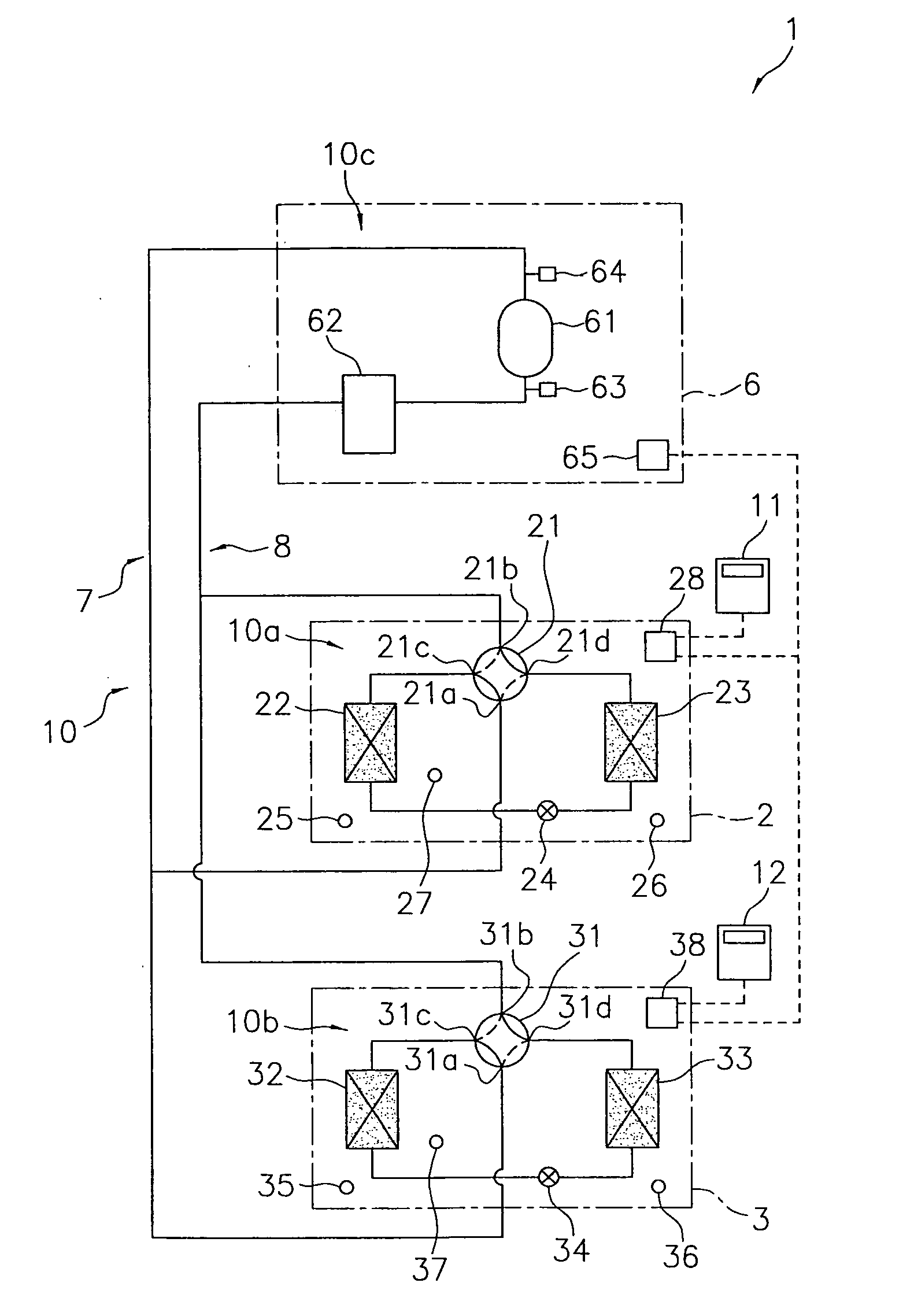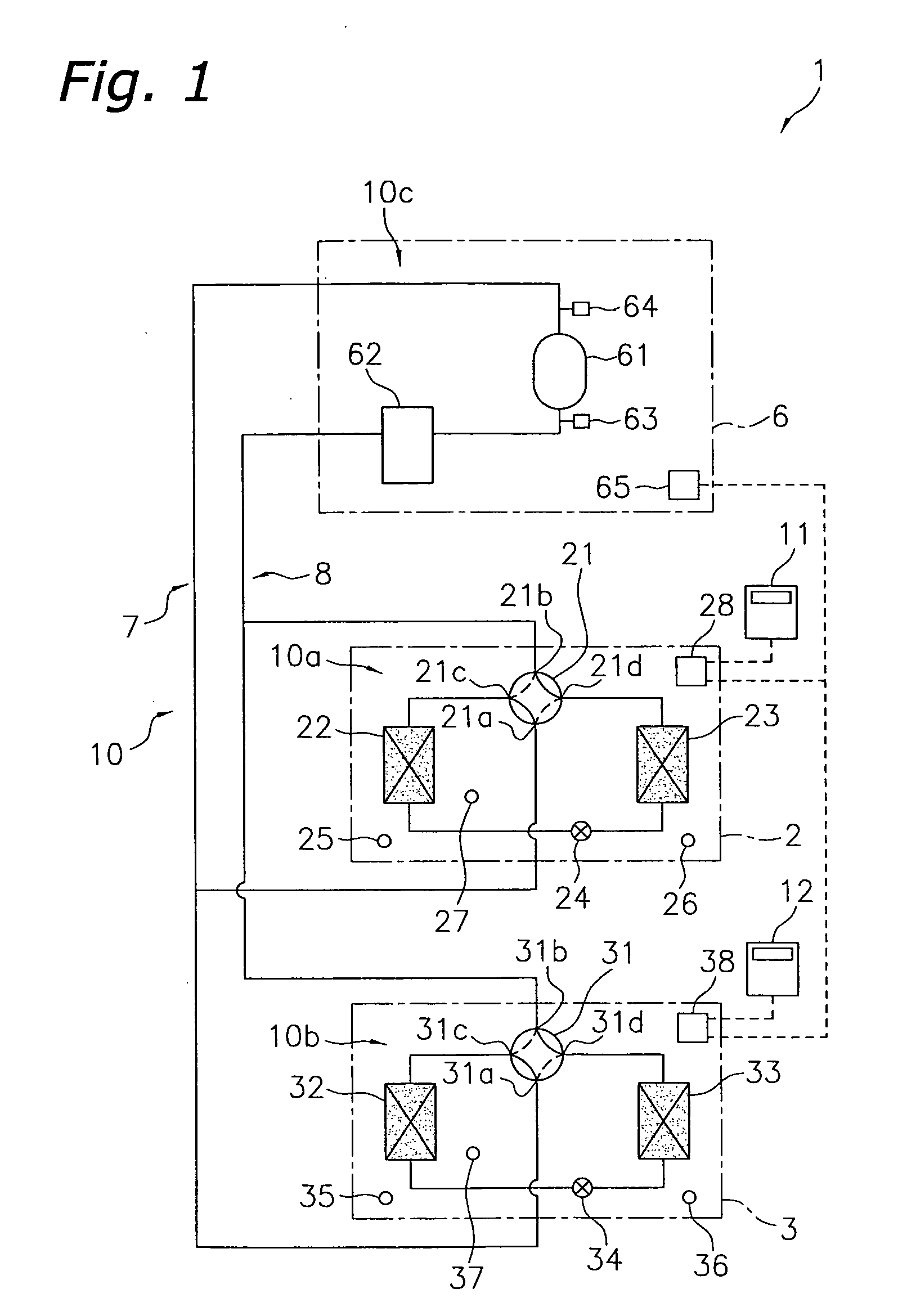Air conditioning system
a technology of air conditioning system and air conditioner, which is applied in the field of air conditioning system, can solve the problems of reducing the coefficient of performance (cop), not achieving sensible heat load, increasing the number of parts to be maintained, and increasing the cost and cos
- Summary
- Abstract
- Description
- Claims
- Application Information
AI Technical Summary
Benefits of technology
Problems solved by technology
Method used
Image
Examples
first embodiment
(1) Configuration of the Air Conditioning System
[0132]FIG. 1 a schematic diagram of a refrigerant circuit of an air conditioning system 1 of a first embodiment according to the present invention. The air conditioning system 1 is an air conditioning system that treats the latent heat load and the sensible heat load in the room of a building and the like by operating a vapor compression type refrigeration cycle. The air conditioning system 1 is so-called separate type multi air conditioning system, and mainly comprises: a plurality (two in this embodiment) of utilization units 2, 3; a heat source unit 6; and connection pipes 7, 8, which connect the utilization units 2, 3 to the heat source unit 6. In the present embodiment, the heat source unit 6 functions as a heat source that is shared by the utilization units 2, 3. In addition, although the present embodiment has only one heat source unit 6, a plurality of heat source units 6 may be connected in parallel when there are many utiliz...
second embodiment
(1) Configuration of the Air Conditioning System
[0220]FIG. 23 is a schematic diagram of a refrigerant circuit of an air conditioning system 101 of a second embodiment according to the present invention. The air conditioning system 101 is an air conditioning system that treats the latent heat load and the sensible heat load in the room of a building and the like by operating a vapor compression type refrigeration cycle. The air conditioning system 101 is so-called separate type multi air conditioning system, and comprises: a latent heat load treatment system 201 that mainly treats the latent heat load in the room; and a sensible heat load treatment system 301 that mainly treat the sensible heat load in the room.
[0221] The configuration of the latent heat load treatment system 201 is the same as that of the air conditioning system 1 of the first embodiment. Therefore, all reference numerals representing each component of the utilization unit 2 of the first embodiment will be changed...
third embodiment
(1) Configuration of the Air Conditioning System
[0335]FIG. 32 a schematic diagram of a refrigerant circuit of an air conditioning system 401 of a third embodiment according to the present invention. The air conditioning system 401 is an air conditioning system that treats the latent heat load and the sensible heat load in the room of a building and the like by operating a vapor compression type refrigeration cycle. The air conditioning system 401 is so-called separate type multi air conditioning system, and mainly comprises: a latent heat load treatment system 201 that mainly treats the latent heat load in the room; and a sensible heat load treatment system 501 that mainly treat the sensible.
[0336] Since the configurations of the latent heat load treatment system 201 is the same as that of the latent heat load treatment system 201 of the second embodiment, a description of each component thereof will be omitted.
[0337] The sensible heat load treatment system 501 is different from ...
PUM
 Login to View More
Login to View More Abstract
Description
Claims
Application Information
 Login to View More
Login to View More - R&D
- Intellectual Property
- Life Sciences
- Materials
- Tech Scout
- Unparalleled Data Quality
- Higher Quality Content
- 60% Fewer Hallucinations
Browse by: Latest US Patents, China's latest patents, Technical Efficacy Thesaurus, Application Domain, Technology Topic, Popular Technical Reports.
© 2025 PatSnap. All rights reserved.Legal|Privacy policy|Modern Slavery Act Transparency Statement|Sitemap|About US| Contact US: help@patsnap.com



